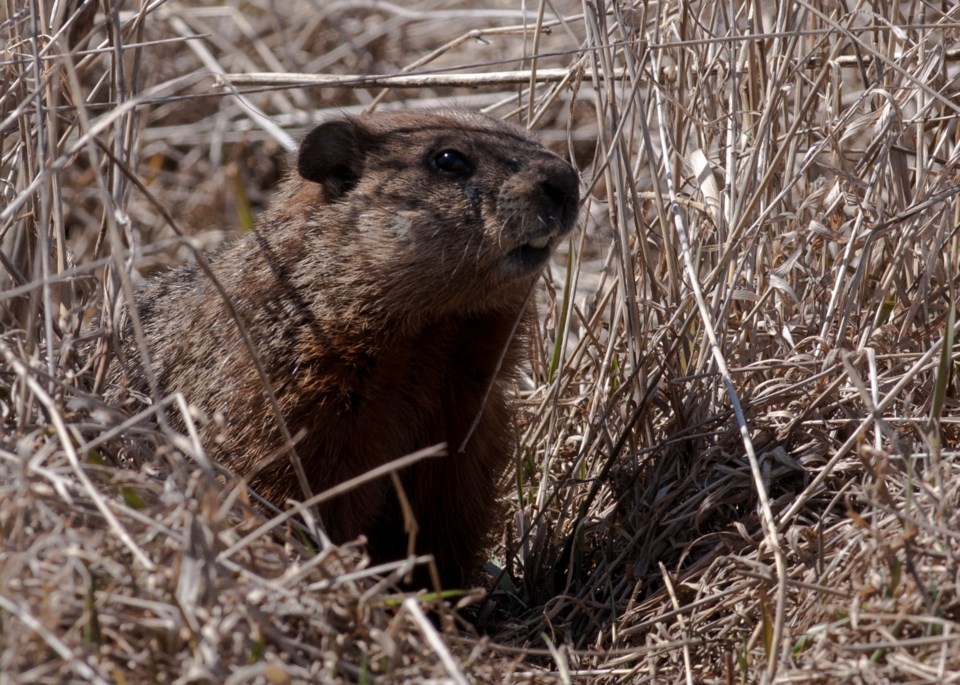As the desperate mid-winter celebration of Groundhog Day sweeps over us, the event at least raises our collective awareness that animals exist.
Even politicians try to edge their way into the shared spotlight, as if perhaps they, too, were responsible for awaking an animal that should, by all laws natural, be in a very deep hibernating sleep.
In my earlier careers as an outdoors educator/natural history interpreter/naturalist, whose job it was to instill a life-long appreciation of the natural environment into Grade 4 students on a two-hour field trip that they didn’t want to be on in the first place, I oft presented a “winter wildlife” program.
I would always expound upon the four choices that wildlife had to survive winter: migrate, hibernate, adapt, or die. Looking back and knowing today what I didn’t know then, makes me cringe a bit as to my curriculum of those good ol’ days.
First up, these are not ‘choices’ that an animal can pick and choose from (“Hey honey, we did hibernation last year, how about we try migration this year?”)
These are survival techniques that biologists have noted that ensure a species is still here next spring. Not a choice, but certainly a defined, evolutionary tested and approved technique.
That term migration means to go away and come back, otherwise it’s just a one-way trip of either emigration (going away) or immigration (arriving). Birds are the most common species to head south where the food is easier to get at, and some insects do so as well.
Waterfowl go to open water, and snowy owls go to open fields. Blue jays migrate too, but only the young ones, and they stay within the usual geographic range of blue jays.
Some critters have found ways to survive by undergoing adaptations, sometimes physical and sometime behavioural. Ruffed grouse grow long scales along the edges of their toes that act like snowshoes, and snowshoe hares grow long, thick bristles on the feet to give credibility to their name.
Snowshoe hares are also called varying hare, as they vary the colour of their fur: brown in summer and white in winter. This cold season adaptation is also done by the short-tailed weasel (also called ermine). The hare does it to avoid predators, the weasel does it to sneak up on prey.
That brings us to hibernation, and here’s where it gets a tad more complex. True hibernation is the incredible reduction of body temperature and rate of breathing. In our area, only groundhogs and jumping mice are known as true hibernators.
These animals eat a lot of fat-producing food in early October and then find a deep underground den in which to curl up for a very long sleep. No food is stored as they will not wake up until at least next March (or, if it is a lab specimen, prodded to wake up unnaturally in early February.)
But what of the animals that do wake up from time to time over the winter months? Are they not hibernating? Nope! They are either bromating or in a torpor.
Animals that wake up and get active on warm winter days are said to be sleeping in a torpor, which is a light sleep with reduced body temperature and breathing. Similar to hibernation but not as deep a sleep. Raccoons, grey squirrels, skunks, chipmunks, and even chickadees can avoid the worst days of winter but emerge to enjoy the sunshiny days.
Some species of fish also fall into a state of torpor, just hanging out motionless near the bottom of the lake. They don’t extract oxygen with lungs that have to take in and then expel air; they instead let the oxygen-rich water wash over their gills and be absorbed as needed.
When the sun shines through the weakening overhead ice and oxygen is again released by underwater vegetation, the fish slowly regain their swish and wiggle.
Brumation is a technique akin to hibernation, and is used by snakes and turtles. Feeding stops in mid-fall so that no food matter remains in the digestive system where it would rot over winter. Snakes will find a deep underground shelter below the frost line yet where water will be available to them. They will remain ‘awake’ all winter and occasionally drink water.
Snapping and painted turtles perform brumation by half-burying themselves in the mud of a river bank or pond. Turtles have lungs, not gills, so oxygen is usually taken in by breathing air.
During brumation, oxygen taken from the water through the blood-rich skin of their ‘derriere’. Although a turtle’s metabolism is much reduced, there is still a problem of acids being produced within their body. This acid is neutralized by calcium carbonate being removed from their skeleton and shell and integrated into the blood system.
Turtles have been commonly observed swimming around under the ice on clear winter days. They return to a state of brumation after a bit of water intake.
Apparently there is talk of sending humans to Mars ... and the past few decades have resulted in much research being conducted by humans trying to figure how they, too, might enter a state of brumation, or even hibernation. Me? A cozy blanket and a 10-minute longer snooze keeps me happy.
